人教版七年级英语下册unit 1教学设计
- 格式:doc
- 大小:13.50 KB
- 文档页数:2
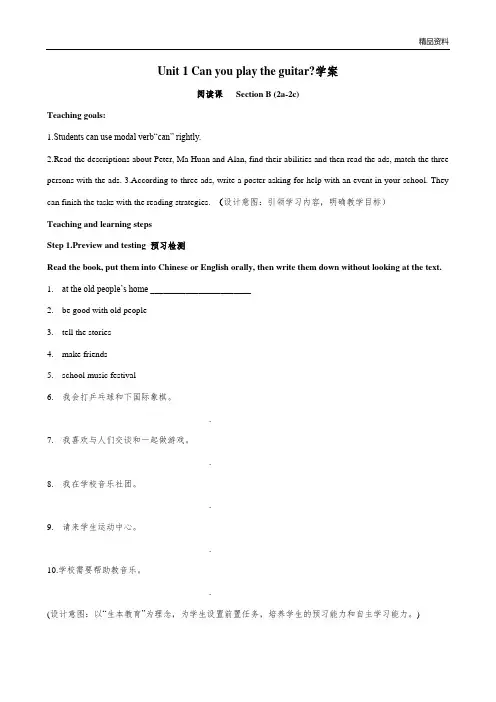
Unit 1 Can you play the guitar?学案阅读课Section B (2a-2c)Teaching goals:1.Students can use modal verb“can” rightly.2.Read the descriptions about Peter, Ma Huan and Alan, find their abilities and then read the ads, match the three persons with the ads.3.According to three ads, write a poster asking for help with an event in your school. They can finish the tasks with the reading strategies. (设计意图:引领学习内容,明确教学目标)Teaching and learning stepsStep 1.Preview and testing 预习检测Read the book, put them into Chinese or English orally, then write them down without looking at the text.1.at the old people’s home _______________________2.be good with old people________________________3.tell the stories___________________4.make friends ____________________5.school music festival_____________6.我会打乒乓球和下国际象棋。
__________________________________.7.我喜欢与人们交谈和一起做游戏。
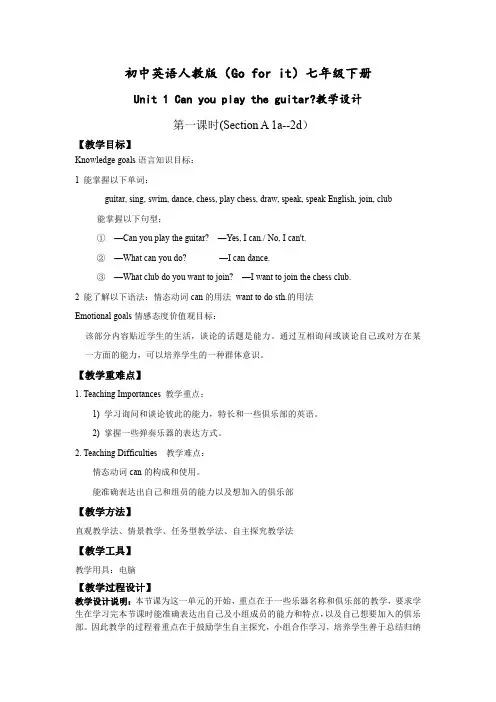
初中英语人教版(Go for it)七年级下册Unit1Can you play the guitar?教学设计第一课时(Section A1a--2d)【教学目标】Knowledge goals语言知识目标:1能掌握以下单词:guitar,sing,swim,dance,chess,play chess,draw,speak,speak English,join,club能掌握以下句型:①—Can you play the guitar?—Yes,I can./No,I can't.②—What can you do?—I can dance.③—What club do you want to join?—I want to join the chess club.2能了解以下语法:情态动词can的用法want to do sth.的用法Emotional goals情感态度价值观目标:该部分内容贴近学生的生活,谈论的话题是能力。
通过互相询问或谈论自己或对方在某一方面的能力,可以培养学生的一种群体意识。
【教学重难点】1.Teaching Importances教学重点:1)学习询问和谈论彼此的能力,特长和一些俱乐部的英语。
2)掌握一些弹奏乐器的表达方式。
2.Teaching Difficulties教学难点:情态动词can的构成和使用。
能准确表达出自己和组员的能力以及想加入的俱乐部【教学方法】直观教学法、情景教学、任务型教学法、自主探究教学法【教学工具】教学用具:电脑【教学过程设计】教学设计说明:本节课为这一单元的开始,重点在于一些乐器名称和俱乐部的教学,要求学生在学习完本节课时能准确表达出自己及小组成员的能力和特点,以及自己想要加入的俱乐部。
因此教学的过程着重点在于鼓励学生自主探究,小组合作学习,培养学生善于总结归纳知识,善于反思的品质。
设计主线为:新学期学校俱乐部招新,欣赏学生才艺展示。
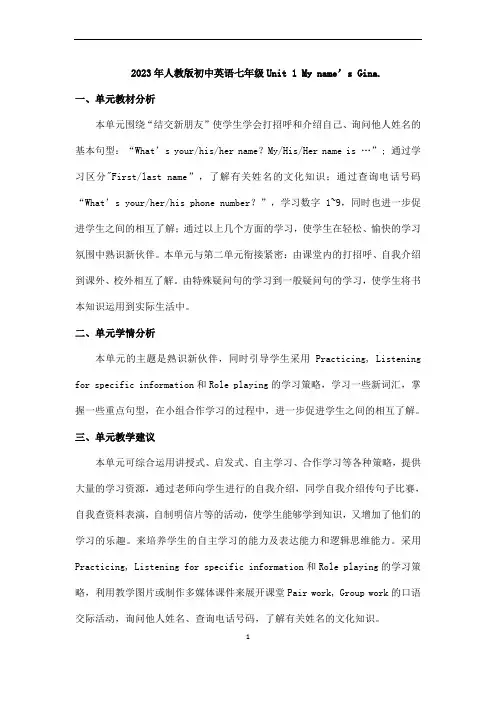
2023年人教版初中英语七年级Unit 1 My name’s Gina.一、单元教材分析本单元围绕“结交新朋友”使学生学会打招呼和介绍自己、询问他人姓名的基本句型:“What’s your/his/her name?My/His/Her name is …”; 通过学习区分"First/last name”,了解有关姓名的文化知识;通过查询电话号码“What’s your/her/his phone number?”,学习数字1~9,同时也进一步促进学生之间的相互了解;通过以上几个方面的学习,使学生在轻松、愉快的学习氛围中熟识新伙伴。
本单元与第二单元衔接紧密:由课堂内的打招呼、自我介绍到课外、校外相互了解。
由特殊疑问句的学习到一般疑问句的学习,使学生将书本知识运用到实际生活中。
二、单元学情分析本单元的主题是熟识新伙伴,同时引导学生采用Practicing, Listening for specific information和Role playing的学习策略,学习一些新词汇,掌握一些重点句型,在小组合作学习的过程中,进一步促进学生之间的相互了解。
三、单元教学建议本单元可综合运用讲授式、启发式、自主学习、合作学习等各种策略,提供大量的学习资源,通过老师向学生进行的自我介绍,同学自我介绍传句子比赛,自我查资料表演,自制明信片等的活动,使学生能够学到知识,又增加了他们的学习的乐趣。
来培养学生的自主学习的能力及表达能力和逻辑思维能力。
采用Practicing, Listening for specific information和Role playing的学习策略,利用教学图片或制作多媒体课件来展开课堂Pair work, Group work的口语交际活动,询问他人姓名、查询电话号码,了解有关姓名的文化知识。
四、单元课时分配本单元可用4课时完成教学任务:Section A (1a-2d) 用1课时Section A (Grammar Focus-3c) 用1课时Section B (1a-2c) 用1课时Section B (3a-Self Check) 用1课时Section A 1 (1a-2d)一、教学目标:1. 语言知识目标:1) 能掌握以下单词: name nice meet his and her your能掌握以下句型:①—Hi. My name’s Gina.—I’m Jenny. Nice to meet you!②—What’s your/his/her name?—My/his her name is…③—Are you…?—Yes, I am. / No, I'm not.④—Is he/she…?—Yes, she/he is. / No, she/he isn’t.2) 能了解以下语法:your, his, her等形容词性物主代词的简单用法;What’s=what is I’m=I am name’s=name is等缩写形式。
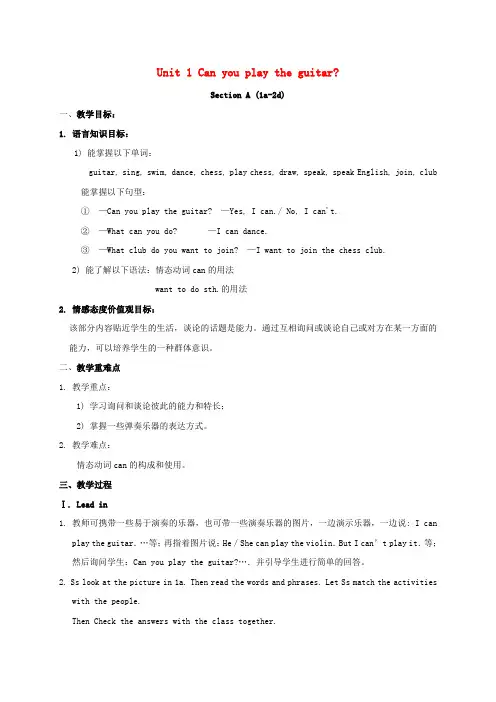
Unit 1 Can you play the guitar?Section A (1a-2d)一、教学目标:1. 语言知识目标:1) 能掌握以下单词:guitar, sing, swim, dance, chess, play chess, draw, speak, speak English, join, club 能掌握以下句型:①—Can you play the guitar? —Yes, I can./ No, I can't.②—What can you do? —I can dance.③—What club do you want to join? —I want to join the chess club.2) 能了解以下语法:情态动词can的用法want to do sth.的用法2. 情感态度价值观目标:该部分内容贴近学生的生活,谈论的话题是能力。
通过互相询问或谈论自己或对方在某一方面的能力,可以培养学生的一种群体意识。
二、教学重难点1. 教学重点:1) 学习询问和谈论彼此的能力和特长;2) 掌握一些弹奏乐器的表达方式。
2. 教学难点:情态动词can的构成和使用。
三、教学过程Ⅰ. Lead in1. 教师可携带一些易于演奏的乐器,也可带一些演奏乐器的图片,一边演示乐器,一边说: I canplay the guitar.…等;再指着图片说:He/She can play the violin.But I can’t play it.等;然后询问学生:Can you play the guitar?….并引导学生进行简单的回答。
2. Ss look at the picture in 1a. Then read the words and phrases. Let Ss match the activitieswith the people.Then Check the answers with the class together.Ⅱ. Presentation出示一些反映各种活动的图片、幻灯片或播放课件,引导学生谈论活动:He/She can dance/swim/sing/"··But I can’t dance/swim/sing/...等,学习表达活动的动词短语。
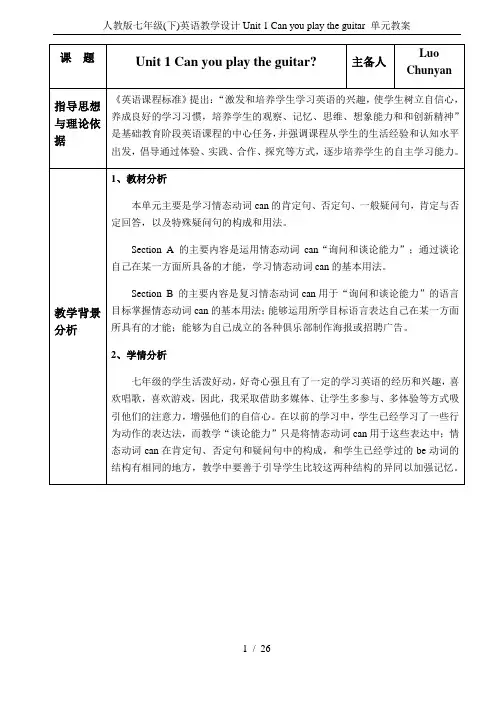
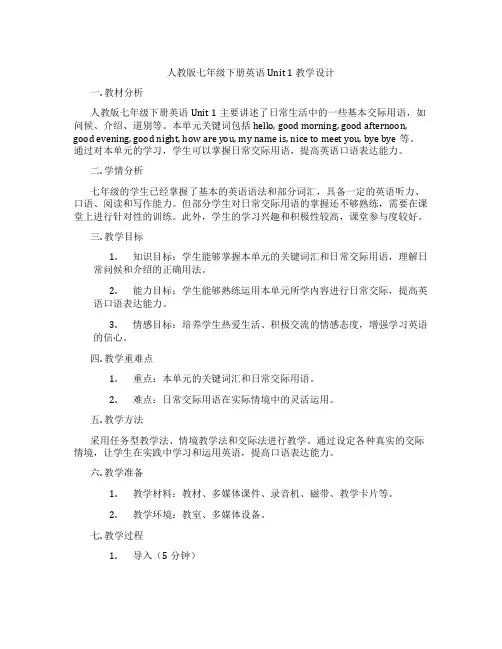
人教版七年级下册英语Unit 1 教学设计一. 教材分析人教版七年级下册英语Unit 1主要讲述了日常生活中的一些基本交际用语,如问候、介绍、道别等。
本单元关键词包括hello, good morning, good afternoon, good evening, good night, how are you, my name is, nice to meet you, bye bye等。
通过对本单元的学习,学生可以掌握日常交际用语,提高英语口语表达能力。
二. 学情分析七年级的学生已经掌握了基本的英语语法和部分词汇,具备一定的英语听力、口语、阅读和写作能力。
但部分学生对日常交际用语的掌握还不够熟练,需要在课堂上进行针对性的训练。
此外,学生的学习兴趣和积极性较高,课堂参与度较好。
三. 教学目标1.知识目标:学生能够掌握本单元的关键词汇和日常交际用语,理解日常问候和介绍的正确用法。
2.能力目标:学生能够熟练运用本单元所学内容进行日常交际,提高英语口语表达能力。
3.情感目标:培养学生热爱生活、积极交流的情感态度,增强学习英语的信心。
四. 教学重难点1.重点:本单元的关键词汇和日常交际用语。
2.难点:日常交际用语在实际情境中的灵活运用。
五. 教学方法采用任务型教学法、情境教学法和交际法进行教学。
通过设定各种真实的交际情境,让学生在实践中学习和运用英语,提高口语表达能力。
六. 教学准备1.教学材料:教材、多媒体课件、录音机、磁带、教学卡片等。
2.教学环境:教室、多媒体设备。
七. 教学过程1.导入(5分钟)利用多媒体课件展示一幅日常生活场景图,引导学生观察并回答以下问题:–What can you see in the picture?–What are they doing?–How are they feeling?通过这些问题激发学生的学习兴趣,为接下来的教学活动做好铺垫。
2.呈现(10分钟)教师展示本节课的关键词汇和日常交际用语,如hello, good morning, how are you, my name is等,并用肢体语言和实物辅助教学,让学生更好地理解和记忆。
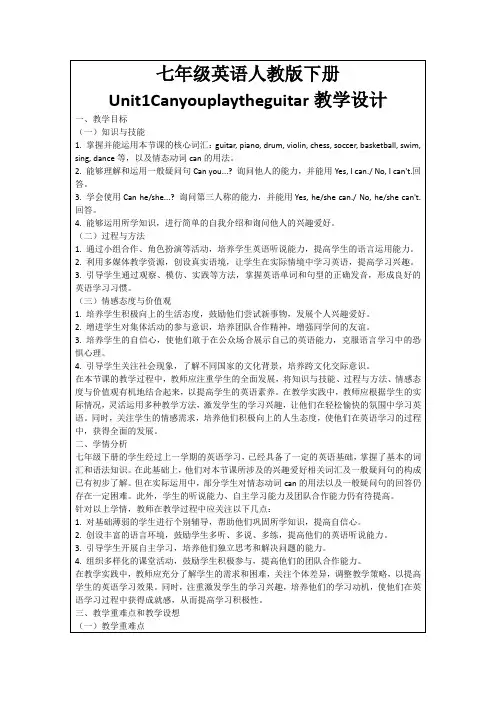

人教版英语七下unit1单元作业设计Unit 1 of the 7th grade English textbook published by People's Education Press is a crucial part of the curriculum. This unit covers various topics such as personal information, interests, and daily routines. Learning this unit is essential for students to acquire basic communication skills in English.在人教版七年级英语教材的第一单元中,涵盖了个人信息、兴趣爱好和日常生活等多个话题。
学生学习这一单元对于他们掌握基础的英语交流技能至关重要。
The unit starts with introducing basic greetings and asking aboutone's name and age. These are fundamental aspects of communication and lay the foundation for further language learning. By practicing these phrases, students can gradually improve their speaking and listening skills.这个单元从介绍基本的问候语和询问姓名年龄开始。
学生通过练习这些短语,可以逐渐提高他们的口语和听力技能。
Furthermore, unit 1 also includes vocabulary related to hobbies and interests. Students are encouraged to express their preferences and talk about what they enjoy doing in their free time. This not only helps them expand their vocabulary but also enhances their ability to communicate about personal interests.此外,单元1还包括与爱好和兴趣相关的词汇。
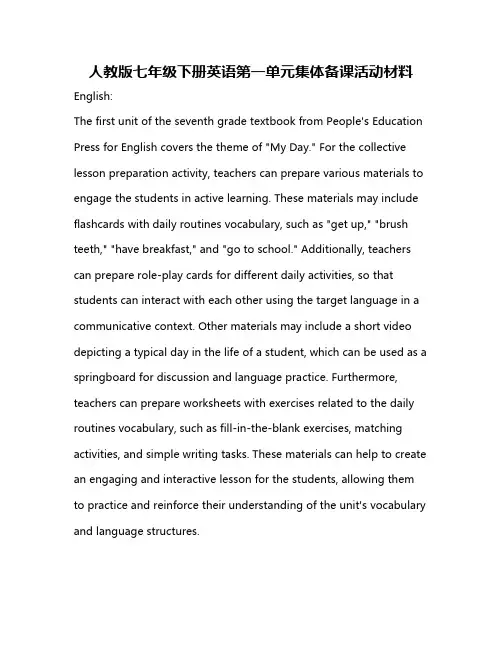
人教版七年级下册英语第一单元集体备课活动材料English:The first unit of the seventh grade textbook from People's Education Press for English covers the theme of "My Day." For the collective lesson preparation activity, teachers can prepare various materials to engage the students in active learning. These materials may include flashcards with daily routines vocabulary, such as "get up," "brush teeth," "have breakfast," and "go to school." Additionally, teachers can prepare role-play cards for different daily activities, so that students can interact with each other using the target language in a communicative context. Other materials may include a short video depicting a typical day in the life of a student, which can be used as a springboard for discussion and language practice. Furthermore, teachers can prepare worksheets with exercises related to the daily routines vocabulary, such as fill-in-the-blank exercises, matching activities, and simple writing tasks. These materials can help to create an engaging and interactive lesson for the students, allowing them to practice and reinforce their understanding of the unit's vocabulary and language structures.中文翻译:人教版七年级英语教材的第一单元涵盖了“我的一天”的主题。
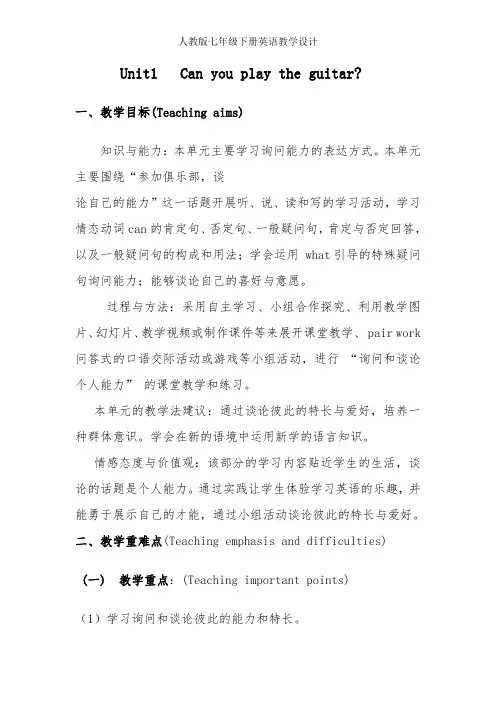
Unit1Can you play the guitar?一、教学目标(Teaching aims)知识与能力:本单元主要学习询问能力的表达方式。
本单元主要围绕“参加俱乐部,谈论自己的能力”这一话题开展听、说、读和写的学习活动,学习情态动词can的肯定句、否定句、一般疑问句,肯定与否定回答,以及一般疑问句的构成和用法;学会运用 what引导的特殊疑问句询问能力;能够谈论自己的喜好与意愿。
过程与方法:采用自主学习、小组合作探究、利用教学图片、幻灯片、教学视频或制作课件等来展开课堂教学、 pair work 问答式的口语交际活动或游戏等小组活动,进行“询问和谈论个人能力”的课堂教学和练习。
本单元的教学法建议:通过谈论彼此的特长与爱好,培养一种群体意识。
学会在新的语境中运用新学的语言知识。
情感态度与价值观:该部分的学习内容贴近学生的生活,谈论的话题是个人能力。
通过实践让学生体验学习英语的乐趣,并能勇于展示自己的才能,通过小组活动谈论彼此的特长与爱好。
二、教学重难点(Teaching emphasis and difficulties)(一) 教学重点:(Teaching important points)(1)学习询问和谈论彼此的能力和特长。
(2)理解情态动词can的构成和使用,掌握情态动词can的肯定句和否定句,一般疑问句及肯定,否定回答(3)能够就自己的喜好与意愿这一话题分角色表演对话;能够制作海报;会写招聘广告。
(二)教学难点:(Teaching difficult points)(1)学习询问和谈论彼此的能力和特长。
(2)使用情态动词can表示能力。
(3)把情态动词can的教学有机融入情景教学中。
三、教学策略(Teaching strategies)语音教学让学生进行模仿操练;词汇教学采取情景介绍或演示对比的方式进行教学,让学生在情境中操练、理解含义,并学会运用;口语教学采取 pair work 问答式的口语交际活动或游戏等小组活动互相操练。

1.介绍Unit 1内容Unit 1是七年级英语下册的第一个单元,主要内容包括介绍自己、询问他人基本信息和表达自己的喜好。
通过学习本单元,学生将能够掌握一些简单的英语交流技巧,为今后的学习打下基础。
2.单元重点本单元的重点是学会用英语介绍自己、询问他人基本信息以及表达自己的喜好。
学生将学习一些基本的句型和词汇,并通过练习提高自己的口语表达能力。
3.教学目标通过本单元的学习,学生将能够:- 掌握一些基本的英语交流用语和句型- 能够用英语介绍自己的尊称、芳龄、爱好等基本信息- 能够用英语询问他人的基本信息- 能够用英语表达自己的喜好和不喜欢的事物- 能够进行简单的英语对话交流4.教学内容本单元包括以下内容:- 自我介绍:学生将学会用英语介绍自己的尊称、芳龄、爱好、家庭成员等基本信息。
- 询问他人信息:学生将学会用英语询问他人的尊称、芳龄、爱好等基本信息。
- 表达喜好:学生将学会用英语表达自己的喜好和不喜欢的事物,并学习相关的形容词和词汇。
5.教学方法本单元的教学将采用多种教学方法,包括听力训练、口语练习、词汇记忆、语法讲解等。
教师将通过多种活动形式,激发学生的学习兴趣,提高学生的学习积极性。
6.教学建议在教学过程中,教师可以通过图片、视瓶等教具引发学生的兴趣,激发学生的学习热情。
通过组织学生进行角色扮演、小组讨论等活动,提高学生的口语表达能力,增强学生的实际交流能力。
7.教学评估在教学结束后,可以通过口语测试、写作测试、听力测试等多种形式对学生进行综合评估,了解学生对本单元知识的掌握情况。
可以通过课堂表现、作业完成情况等对学生进行日常评估。
8.总结本单元是七年级英语下册的第一个单元,重点在于学会用英语进行自我介绍、询问他人基本信息以及表达自己的喜好。
通过本单元的学习,学生将打好英语学习的基础,为今后的学习奠定坚实的基础。
9.课堂活动设计在教学中,老师可以设计多样化的课堂活动来帮助学生更好地掌握本单元的内容。
人教版七年级下英语第一课As a seventh grader in the People's Education Edition English class, the first lesson focuses on introducing oneself. Learning how to talk about oneself is an essential skill in language learning and communication. When we can effectively communicate about our interests, hobbies, and backgrounds, we can form connections with others and build meaningful relationships. This lesson is designed to help students become more confident in expressing themselves in English.作为人教版七年级学生,《关于自我介绍》是第一课的内容。
学会如何谈论自己是语言学习和交流中的重要技能。
当我们能够有效地谈论自己的兴趣、爱好和背景时,我们可以与他人建立联系,建立有意义的关系。
这节课旨在帮助学生在英语中更自信地表达自己。
Introducing oneself in a new language can be challenging, as it requires not only vocabulary and grammar skills but also confidence and self-expression. Many students may feel nervous or unsure about speaking in English, especially when talking about themselves. However, through practice and guidance from the teacher, studentscan gradually build their confidence and improve their communication skills. This lesson provides a safe space for studentsto practice and receive feedback on their speaking abilities.用一种新语言介绍自己可能是具有挑战性的,因为它不仅需要词汇和语法技能,还需要自信和自我表达能力。
人教版七年级英语下册第一单元作文教学设计Unit 1 My DayTeaching Objectives:1. Students will be able to write a short composition in English about their daily routines.2. Students will be able to use the present simple tense correctly in their writing.3. Students will be able to use sequencing words (first, then, next, finally) in their writing.4. Students will be able to improve their vocabulary related to daily routines.Teaching Procedures:Introduction (10 minutes):1. Greet the students and introduce the topic of the lesson: daily routines.2. Show the students a sample composition about daily routines and discuss the key points with them.3. Write new vocabulary related to daily routines on the board and teach the pronunciation and meaning of each word.Practice (20 minutes):1. Divide the students into pairs and ask them to brainstorm their own daily routines.2. Monitor the students as they work and offer help when needed.3. Have each pair write a short composition about their daily routines using the present simple tense and sequencing words.4. Encourage the students to use the new vocabulary they have learned in their writing.Presentation (15 minutes):1. Ask each pair to read their composition aloud to the class.2. Provide feedback on the students' grammar, vocabulary, and pronunciation.3. Encourage the students to ask questions and give suggestions to their classmates.Consolidation (10 minutes):1. Review the key points of the lesson, including the use of the present simple tense, sequencing words, and new vocabulary.2. Ask the students to write a final draft of their compositions, incorporating any feedback they received.Homework (5 minutes):1. Assign the students homework to write a short composition about a typical day in their life.2. Remind the students to use the present simple tense, sequencing words, and new vocabulary in their writing.Evaluation:1. Assess the students' compositions based on their use of the present simple tense, sequencing words, vocabulary, and overall writing skills.2. Provide feedback to the students to help them improve their writing in future lessons.。
人教版七年级英语下册unit 1教学设计
一、教学目标:
1. 语言知识目标:
1) 能掌握以下单词:
guitar, sing, swim, dance, chess, play chess, draw, speak, speak English, join, club
能掌握以下句型:
①—Can you play the guitar? —Yes, I can./ No, I can't.
②—What can you do? —I can dance.
③—What club do you want to join? —I want to join the
chess club.
2) 能了解以下语法:情态动词can的用法
want to do sth.的用法
2. 情感态度价值观目标:
该部分内容贴近学生的生活,谈论的话题是能力。
通过互相询问或谈论自己或对方在某一方面的能力,可以培养学生的一种群体意识。
二、教学重难点
1. 教学重点:
1) 学习询问和谈论彼此的能力和特长;
2) 掌握一些弹奏乐器的表达方式。
2. 教学难点:
情态动词can的构成和使用。
三、教学过程
Ⅰ.Lead in
1. 教师可携带一些易于演奏的乐器,也可带一些演奏乐器的图片,一边演示乐器,
一边说: I can play the guitar.…等;再指着图片说:He/
She can play the violin.But I can’t play it.等;然后询问学生:Can you play the guitar?….并引导学生进行简单的回答。
2. Ss look at the picture in 1a. Then read the words and
phrases. Let Ss match the
activities with the people.
1/14页
Then Check the answers with the class together.
Ⅱ.Presentation
出示一些反映各种活动的图片、幻灯片或播放课件,引导学生谈论活动:He /She can dance/swim/sing/"··But I can’t dance/swim/sing/...等,学习表达活动的动词短语。
Ⅲ.Game (What can I do?)
T: Tell your partners what you can do. For example:
I can play the guitar. I can sing and dance.
Ss work in groups. The let some Ss talk to their classmat
es in front of the class. Ⅳ.Listening
1. T: Now let’s listen to the tape, find out the right conversation, and number them
1-3.
(播放lb部分的录音让学生听,引导学生根据所听到的内容,选出对话的
顺序,完成1b部分的教学任务。
)
2. Check the answers: (3, 2, 1 )
Ⅴ.Pair work
1. Ask the Ss to practice the conversations in 1b with a
partner. Then make their own conversations.
(引导学生展开Pairwork活动,完成lc部分口语交际的教学任务,学会运用can 询问和表达能力。
)
Ⅵ.Listening
1. Work on 2a;
T: Now, look at the pictures on P2, listen to the four c onversations. Just listen.
(Play the recording for the first time, students only liste n carefully.)
Then, listen to the recording again, and circle the clubs you hear.
Check the answers with the class.
2. Work on 2b;
引导学生根据对话内容用正确的单词填空,补全对话,再播放听力材料一遍。
让学生进行校对,练习听力和写作能力,完成2b部分的教学任务。